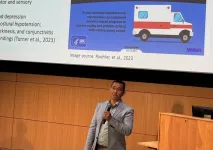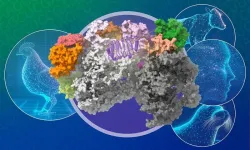(Press-News.org) Editor’s note: NCSA is cohosting an International Summit on a Computational System for Frontier Earth System Science and Climate Simulation & Projection September 29 through October 2, 2024 at the University of Illinois Urbana-Champaign.
Toward a Computational Framework for Earth System Models at Kilometer Resolution to Support Earth System Science and Climate Projection
By Kelvin K. Droegemeier, Professor of Atmospheric Science and Special Advisor to the Chancellor for Science and Policy at the University of Illinois Urbana-Champaign
Almost daily, and often without realizing it, we rely upon computers to guide our decisions. Whether finding the fastest route using GPS on our smartphone or selecting the lowest-cost item when shopping online, computers help us make informed choices. Likewise, computers are essential in weather and climate applications, where estimating the future and knowing the likelihood of outcomes can mean the difference between life and death.
For many decades, both numerical weather prediction (NWP) models and their more complex Earth system model (ESM) cousins have been among the world’s foremost drivers of high-performance computational systems. Today, NWP models are run at operational centers across the globe, producing forecasts valid for a few hours out to two weeks on scales ranging from local to global. Such models also are used routinely for academic and commercial purposes.
Similarly, extremely sophisticated ESMs – usually developed by large teams or the broader community and made available as community resources – are now run by some 50 groups globally to understand the behavior of our planet and to project future climate states under a wide variety of scenarios regarding human and natural activity. Importantly, such work is foundational to major climate assessments in the United States and internationally.
Contemporary NWP models and ESMs share many characteristics, including requiring the most powerful computers available and needing to quantify uncertainties inherently present in their solutions. They also differ in several ways. Whereas both solve complex equations governing atmospheric motion, thermodynamics, cloud and precipitation processes, radiation physics, land-surface/atmosphere interactions, vegetation, soil moisture and groundwater, ocean circulations and sea ice, ESMs also include slowly changing processes associated with atmospheric gases and particulates, biogeochemical cycles, ice sheets and marine ecosystems. ESMs also accommodate natural forcings such as volcanic eruptions and variations in solar output, as well as anthropogenic forcings, such as human-induced greenhouse gas emissions and land use and land cover changes.
Because NWP models forecast weather for around two weeks using domains ranging from regional to global, they can employ fine spacings in their computational meshes. Conversely, because climate models project future climate states many decades to a century or more in the future, and because they also involve additional physical processes, they are forced to use much coarser meshes, leading to poorer representation of coastal processes, land-atmosphere processes, tropical cyclones, topographic forcing, cloud and precipitation processes, and extreme events. These limitations sometimes manifest as significant biases and misrepresentations of key factors governing the weather and climate system.
That is not to say ESMs are somehow horribly flawed. Indeed, they are elegantly sophisticated and from them we have learned a great deal about the behavior and global and regional trends of the atmosphere, oceans and other elements of the Earth system. The sad truth, however, is that ESMs are like sleek Formula 1 racecars, which, owing to current computational limitations, can only be driven in a small parking lot. Artificial intelligence (AI) and machine learning (ML) are fundamentally transforming our ability to forecast weather, mostly because of the ability to train ML-based models using decades of observations and forecasts. Although such advances are evolving more slowly in climate projection, they are playing increasingly important roles in ESMs and are an integral part of an international summit coordinated by the University of Illinois Urbana-Champaign this fall.
Kelvin K. Droegemeier, Professor of Atmospheric Science and Special Advisor to the Chancellor for Science and Policy
The above discussion leads to a particularly important question. If we were somehow able to run ESMs at global spatial resolutions like those of today’s NWP models – resolutions that would unlock the full capability of ESMs and uncover masked limitations – would this yield significant improvements in our understanding of climate change and the ability to project future climate states? Interestingly and fortuitously, a similar question began to be addressed a few decades ago for NWP when model resolutions were taken experimentally from a few tens of kilometers down to a few kilometers and the models initialized with fine-resolution data, especially from Doppler weather radars (e.g., Lilly 1991, Droegemeier 1997). Subsequent results were stunning (e.g., Youssof et al. 2016), leading some to characterize the resulting transition of such models to operations as a revolution (The Royal Society 2021). Equally stunning is that theory suggested events such as convective storms were numerically predictable for only an hour or so (Lorenz 1969). Today, such weather is being forecast several hours in advance using operational NWP models, transforming our ability to anticipate, manage and recover. Could such a revolution occur in Earth system modeling?
Numerous studies have made clear (e.g., Palmer and Stevens 2019) that the broad dimensions of climate change (e.g., global warming due to increases in greenhouse gas concentrations) have long been known and do not require sophisticated ESMs run at high resolution. However, such models run at high resolution are needed to address sources of model bias, which in some cases is significant; the pace of warming; local and regional impacts; and details of clouds and precipitation, including severe storms, hurricanes and flash floods (Palmer and Stevens 2019). Although such resolutions are not yet available globally, they have been achieved regionally via dynamical downscaling, which involves embedding a fine-scale ESM computational mesh within a coarser global mesh. Such experiments have yielded tremendous insight into local and regional impacts. Unfortunately, they are, in most cases, unable to capture the upscale and downscale interactions which connect local and regional processes with global ones, and often do not provide data for regions that are most vulnerable to climate change impacts such as the Global South.
Reflecting on the importance of model resolution and how lessons learned from NWP might be leveraged in climate modeling, The Royal Society (2021) noted that “…the lack of capacity to simulate [physical processes] in fine detail accounts for the most significant uncertainties in future climate, especially at the regional and local levels.” They go on to say, “Meanwhile, over those same 30 years of IPCC reports, there has been a ‘quiet revolution’ in weather forecasting. Weather models are now delivering global predictions at 10-kilometre resolution, and regional forecasts at the kilometre-scale. So why hasn’t climate modelling followed the same path? Quite simply it is because the scale of computing power required to perform multi-century global simulations for multiple scenarios at pace eclipses what is needed to make operational weather forecasts for the next few weeks.”
It is clear the value of fine resolution for NWP is no longer debated and has at least partially inspired approximately a dozen groups around the world to establish ESMs that can be run at global kilometer mesh spacing. Many of these groups are incorporating AI and ML in creative ways to improve accuracy and performance (e.g., Kochkov et al. 2024), recognizing that numerous model runs are needed in an ensemble context to quantify uncertainty (e.g., Bouallegue et al. 2024). Indeed, fine-resolution ESMs are not a “silver bullet” and should be utilized in tandem with AI/ML tools to achieve desired goals. Yet, the need for fine-resolution ESM codes is only part of the story. The other part involves the computational systems on which they are to be run and leads to the following question: Will the evolution of computational systems and AI/ML capabilities, as presently envisioned, be sufficient to support large ensembles of kilometer-scale global climate simulations soon enough to help answer key scientific questions, to train ML-based models of the climate system and to support local and regional decision-making regarding climate change?
The answer would appear to be an emphatic “no!” And with that answer comes the imperative of charting a clear course going forward. Two principal options exist, the first being to continue down the projected path of computational capability, utilizing regional high-resolution climate simulations, advances in AI/ML and dynamically downscaled coarser-grid global simulations on general-purpose machines to understand climate change and its related regional and local impacts. Indeed, such work must continue because its value is indisputable and because advances in AI will continue to improve overall capabilities. The second option is to dramatically disrupt the current technology trend by creating a specialized computational system for Earth system science research and climate projection that accommodates both ESMs and new approaches that couple or tether such models to AI.
The Department of Climate, Meteorology & Atmospheric Sciences has partnered with the National Center for Supercomputing Applications to begin addressing the second option by holding an International Summit on a Computational System for Frontier Earth System Science and Climate Simulation & Projection on its Urbana campus from September 29 through October 2, 2024. Sponsored by a grant from the National Science Foundation, this summit will bring together thought leaders from academia, industry, government and non-profit organizations to examine the need for a computational system and modeling framework that accommodate ESMs run at kilometer resolution globally. Additionally, the summit will address how a globally engaged community framework could be structured to meet this need.
The summit is being organized by the following international team of experts who provided thoughtful comments on this article: Francina Dominguez (University of Illinois Urbana-Champaign), Kelvin K. Droegemeier (University of Illinois Urbana-Champaign), Barb Helland (U.S. Department of Energy, Retired), Ruby Leung (Pacific Northwest National Laboratory), Maria Molina (University of Maryland College Park), Andreas Prein (National Center for Atmospheric Research), Dan Reed (University of Utah), John Shalf (Lawrence Berkeley National Laboratory), Bjorn Stevens (Max Planck Institute for Meteorology) and John Towns (University of Illinois Urbana-Champaign).
This invitation-only event is expected to gather 150 experts in person with more than 50 online. The summit also will be streamed live globally on NCSA’s YouTube channel. More information can be found on the summit webpage.
END
Kelvin K. Droegemeier on ‘Working Toward a Computational Framework to Support Earth System Science and Climate Projection’
The download: Expert viewpoints.
2024-08-19
ELSE PRESS RELEASES FROM THIS DATE:
National Academy of Medicine selects FAU for substance use, opioid crises collaborative
2024-08-19
As of 2024, approximately 2.7 million Americans aged 12 and older were estimated to have misused prescription opioids in the past year. Moreover, alcohol, cannabis, cocaine, methamphetamines, among other substances, reflect a complex landscape that requires ongoing efforts aimed at prevention, treatment and policy changes to address the various issues associated with each substance.
Florida Atlantic University was recently selected to participate in the National Academy of Medicine’s (NAM) Action Collaborative on Combatting Substance Use Opioid Crises Core Competency Implementation Pilot Project. To improve coordination ...
Study finds potential link between DNA markers and aging process
2024-08-19
Researchers at Weill Cornell Medicine and the epigenetics company TruDiagnostic have uncovered DNA markers associated with retroelements, remnants of ancient viral genetic material, in our genes that act as highly accurate epigenetic clocks predicting chronological age. The results support the idea that certain retroelements in the human genome may be involved in aging.
Retroelements have been known to impact gene regulation, gene expression, genomic stability and the trajectory of various human diseases, but their potential as biomarkers for aging had been largely unexplored.
The ...
Improving access to heart-failure screening with saliva
2024-08-19
DENVER, Aug. 19, 2024 — Heart failure is a leading cause of death worldwide and is especially fatal for people who don’t have access to medical facilities. So, a team of researchers aims to bring heart failure screening from the lab to the home. Their point-of-care electrochemical biosensor prototype, which resembles a see-through lateral flow test for COVID-19, can measure levels of two biomarkers for heart failure in as little as 15 minutes from just a drop of saliva.
Trey Pittman, a graduate student at Colorado State University, will present his team’s research at the fall meeting of the American Chemical Society (ACS). ACS Fall 2024 is a hybrid ...
Expanding a child’s heart implant with light
2024-08-19
DENVER, Aug. 19, 2024 — Children born with defects that impair the heart’s lower chambers undergo a series of invasive surgeries early in life. The first surgery includes implantation of a plastic tube called a shunt to improve blood flow. However, as children grow, the shunt is often replaced to accommodate their changing bodies. Now, researchers have designed a shunt that expands when activated by light. If developed successfully, this device could reduce the number of open-chest surgeries these children receive.
The researchers will present their results at the fall meeting of the American Chemical Society (ACS). ACS Fall 2024 ...
New insights on how bird flu crosses the species barrier
2024-08-19
In recent years, public health measures, surveillance, and vaccination have helped bring about significant progress in reducing the impact of seasonal flu epidemics, caused by human influenza viruses A and B. However, a possible outbreak of avian influenza A (commonly known as ‘bird flu’) in mammals, including humans, poses a significant threat to public health.
The Cusack group at EMBL Grenoble studies the replication process of influenza viruses. A new study from this group sheds light on the different mutations that the avian influenza virus can undergo to be able to replicate in mammalian cells.
Some avian influenza ...
Energy companies pressure landowners into fracking, study shows
2024-08-19
BINGHAMTON, N.Y. -- Energy companies use persistent and personalized pressure to get landowners to give permission for hydraulic fracturing (fracking), and even when landowners decline, companies use legalized compulsion to conduct fracking anyway, according to a new study led by researchers at Binghamton University, State University of New York and UNLV.
“Hydraulic fracturing is a controversial issue, but a lot of the controversy has been focused on the big-picture consequences, for the climate and the economy,” said Benjamin Farrer, lead author and former PhD student at Binghamton University. “One of our hopes for this paper is that it will encourage policymakers ...
UC Irvine team says urban street networks, building density shape severity of floods
2024-08-19
Irvine, Calif., Aug. 19, 2024 — Cities around the globe are experiencing increased flooding due to the compounding effects of stronger storms in a warming climate and urban growth. New research from the University of California, Irvine suggests that urban form, specifically the building density and street network of a neighborhood, is also affecting the intensity of flooding.
For a paper published today in Nature Communications, researchers in UC Irvine’s Department of Civil and Environmental Engineering turned to statistical mechanics ...
Nurses play key role in addressing mental well-being for people after a stroke
2024-08-19
Statement Highlights:
The latest research indicates that 16% to 85% of people recovering from a stroke experience at least one psychosocial symptom, including depression, anxiety, stress, fatigue and/or decreased quality of life.
Critical nursing interventions, such as regular mental health screenings, education, symptom management and follow-up care, are key to reducing the negative effects on a patient’s mental well-being after a stroke, yet only a small proportion of patients receive treatment. ...
Why these educators believe whole-class reading creates a sense of community in the classroom
2024-08-19
With teaching methods for reading and writing under constant scrutiny, and high-stakes testing creating intense pressure to teach strictly to state standards, is there still value in whole-class reading?
Two educators believe that whole-class reading should go hand-in-hand with individual instructional reading, and they say it is vital for cultivating a sense of classroom community while developing critical thinking in young minds.
Educators Lynsey Burkins and Franki Sibberson, both teachers and educators from Ohio, have published a book called In Community ...
Researchers develop an instant version of trendy, golden turmeric milk
2024-08-18
DENVER, Aug. 18, 2024 — If you’ve visited a trendy café in the past few years, you might have noticed “golden” turmeric milk on the menu. Though recently advertised as a caffeine-free, healthy coffee alternative, the drink is a fancified version of haldi doodh — a traditional Indian beverage often used as an at-home cold remedy. And now, researchers have developed an efficient method to make a plant-based, instant version that maintains the beneficial properties of the ingredients while also extending its shelf life.
The researchers will present their results at the fall meeting of the American Chemical Society (ACS). ...
LAST 30 PRESS RELEASES:
Making lighter work of calculating fluid and heat flow
Normalizing blood sugar can halve heart attack risk
Lowering blood sugar cuts heart attack risk in people with prediabetes
Study links genetic variants to risk of blinding eye disease in premature infants
Non-opioid ‘pain sponge’ therapy halts cartilage degeneration and relieves chronic pain
AI can pick up cultural values by mimicking how kids learn
China’s ecological redlines offer fast track to 30 x 30 global conservation goal
Invisible indoor threats: emerging household contaminants and their growing risks to human health
Adding antibody treatment to chemo boosts outcomes for children with rare cancer
Germline pathogenic variants among women without a history of breast cancer
Tanning beds triple melanoma risk, potentially causing broad DNA damage
Unique bond identified as key to viral infection speed
Indoor tanning makes youthful skin much older on a genetic level
Mouse model sheds new light on the causes and potential solutions to human GI problems linked to muscular dystrophy
The Journal of Nuclear Medicine ahead-of-print tip sheet: December 12, 2025
Smarter tools for peering into the microscopic world
Applications open for funding to conduct research in the Kinsey Institute archives
Global measure underestimates the severity of food insecurity
Child survivors of critical illness are missing out on timely follow up care
Risk-based vs annual breast cancer screening / the WISDOM randomized clinical trial
University of Toronto launches Electric Vehicle Innovation Ontario to accelerate advanced EV technologies and build Canada’s innovation advantage
Early relapse predicts poor outcomes in aggressive blood cancer
American College of Lifestyle Medicine applauds two CMS models aligned with lifestyle medicine practice and reimbursement
Clinical trial finds cannabis use not a barrier to quitting nicotine vaping
Supplemental nutrition assistance program policies and food insecurity
Switching immune cells to “night mode” could limit damage after a heart attack, study suggests
URI-based Global RIghts Project report spotlights continued troubling trends in worldwide inhumane treatment
Neutrophils are less aggressive at night, explaining why nighttime heart attacks cause less damage than daytime events
Menopausal hormone therapy may not pose breast cancer risk for women with BRCA mutations
Mobile health tool may improve quality of life for adolescent and young adult breast cancer survivors
[Press-News.org] Kelvin K. Droegemeier on ‘Working Toward a Computational Framework to Support Earth System Science and Climate Projection’The download: Expert viewpoints.





